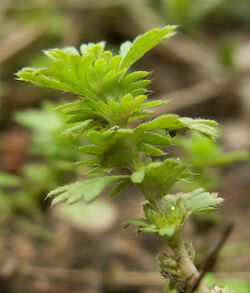Biology:Aphanes
From HandWiki
Short description: Genus of flowering plants
| Aphanes | |
|---|---|

| |
| Aphanes arvensis | |
| Scientific classification | |
| Kingdom: | Plantae |
| Clade: | Tracheophytes |
| Clade: | Angiosperms |
| Clade: | Eudicots |
| Clade: | Rosids |
| Order: | Rosales |
| Family: | Rosaceae |
| Subfamily: | Rosoideae |
| Tribe: | Potentilleae |
| Subtribe: | Fragariinae |
| Genus: | Aphanes L. |
Aphanes (parsley-piert) is a genus of around 20 species[1] in the rose family (Rosaceae), native to Europe, Asia and Australia . A 2003 study indicated that Aphanes may belong to the genus Alchemilla, commonly called lady's-mantle.[2][3] They are slender, annual prostrate herbs, much-branched with deeply lobed leaves, pilose (covered with soft hair) and on short petioles. The tiny green to yellow flowers without petals grow in clusters in the denticulate leaflike stipules.
Species include:
- Aphanes andicola Rothm.
- Aphanes arvensis L. – field parsley-piert, western lady's-mantle, parsley breakstone
- Aphanes australiana – Australian piert
- Aphanes cotopaxiensis Romoleroux & Frost-Olsen
- Aphanes cuneifolia (Nutt.) Rydb.
- Aphanes looseri Rothm.
- Aphanes microcarpa (Boiss. & Reut.) Rothm. (syn. A. australis, A. inexpectata) – slender parsley-piert
- Aphanes occidentalis (Nutt.) Rydb. – dew cup, lady's mantle
References
- ↑ D. J. Mabberley (2008). Mabberley's Plant-book: a Portable Dictionary of Plants, Their Classifications, and Uses. Cambridge University Press. p. 25. ISBN 9780521820714. https://books.google.com/books?id=9RyKKHtwXUYC&pg=PA25.
- ↑ Torsten Eriksson; Malin S. Hibbs; Anne D. Yoder; Charles F. Delwiche; Michael J. Donoghue (2003). "The phylogeny of Rosoideae (Rosaceae) based on sequences of the internal transcribed spacers (ITS) of nuclear ribosomal DNA and the trnL/F region of chloroplast DNA". International Journal of Plant Sciences 164 (2): 197–211. doi:10.1086/346163. http://biology.duke.edu/yoderlab/reprints/2003Eriksson_et_alIJPS.pdf.
- ↑ Ji Young Yang; Jae-Hong Pak (2006). "Phylogeny of Korean Rubus (Rosaceae) based on its (nrDNA) and trnL/F intergenic region (cpDNA)". Journal of Plant Biology 49 (1): 44–54. doi:10.1007/BF03030787.
External links
- "Aphanes L.". Atlas of Living Australia. https://bie.ala.org.au/species/http://id.biodiversity.org.au/node/apni/2912241.
Wikidata ☰ Q159455 entry
 |

